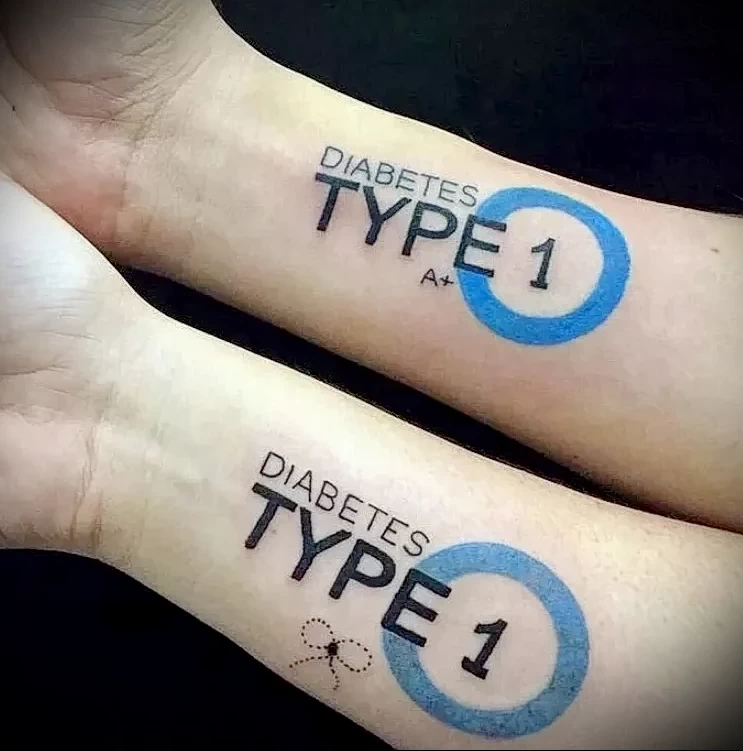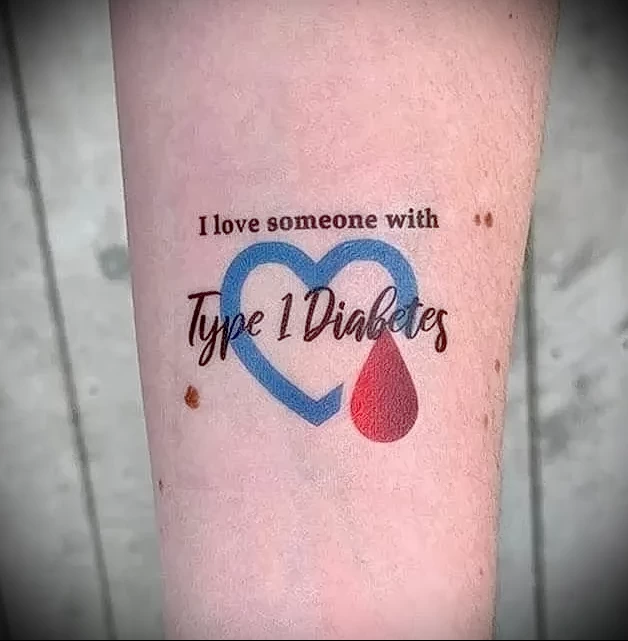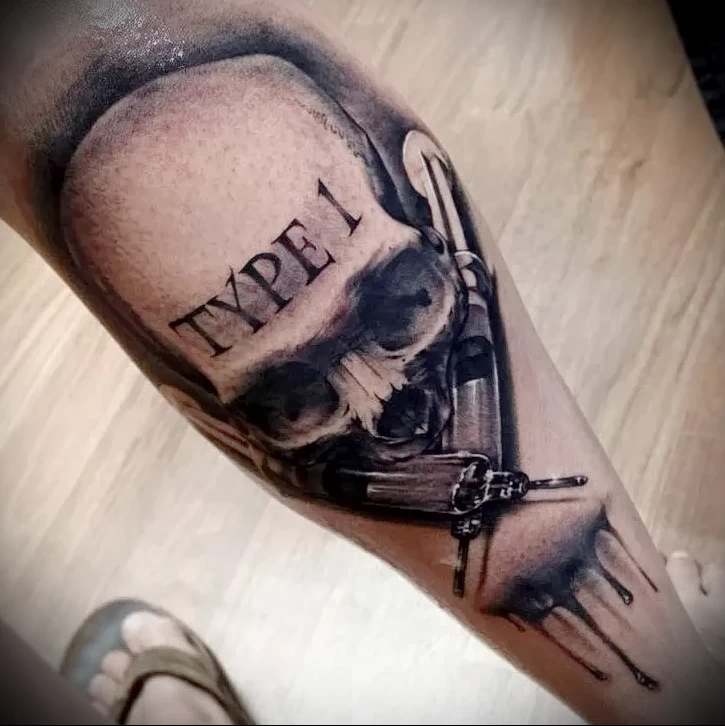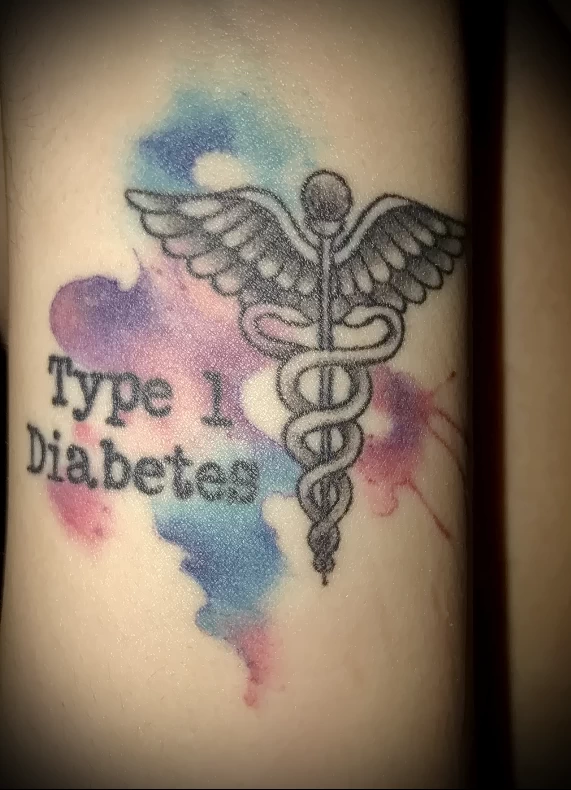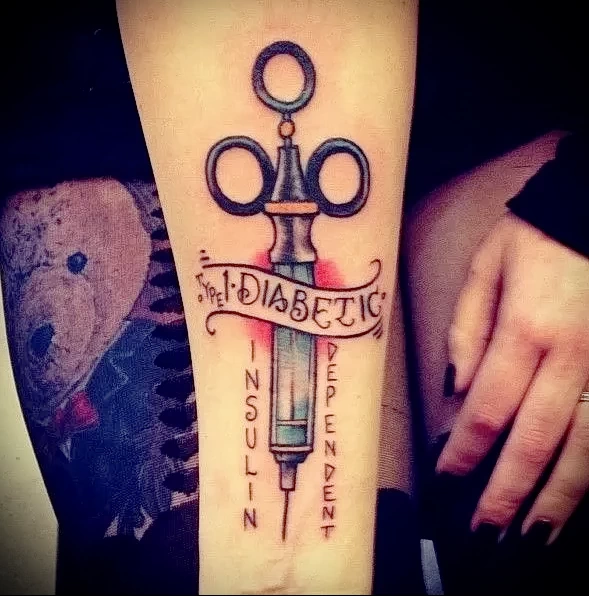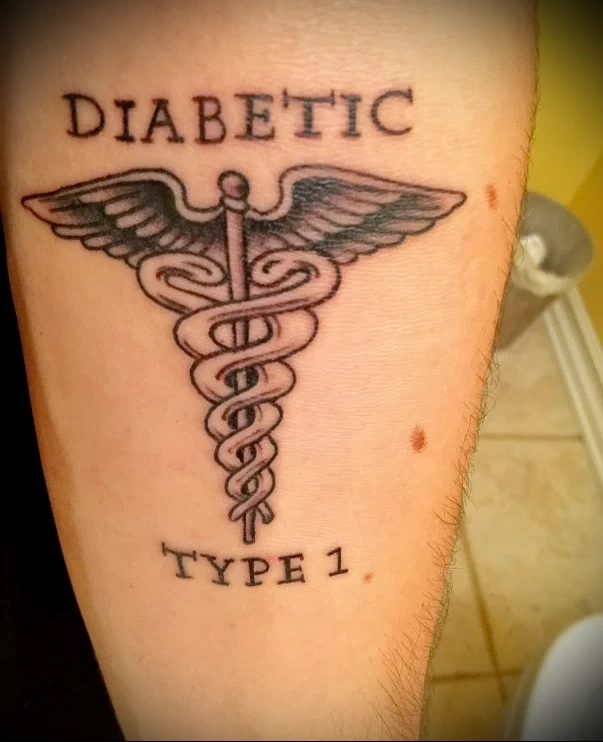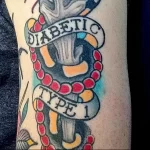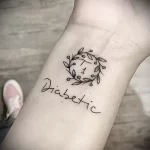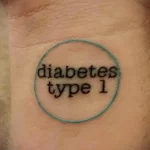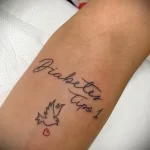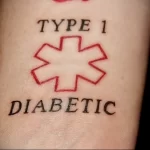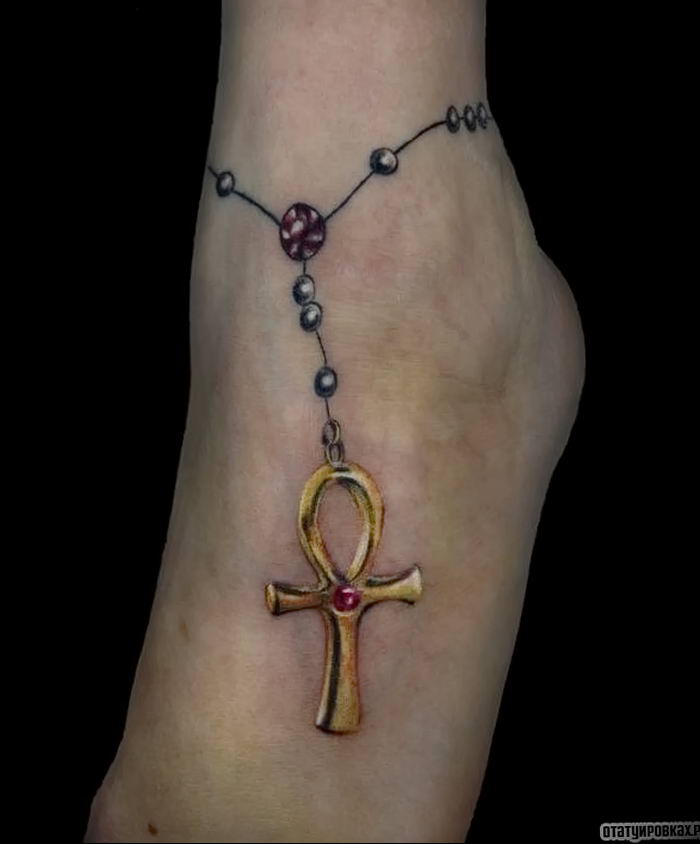In anticipation of World Diabetes Day, we invite you to immerse yourself in the world of tattoos that not only adorn but also tell unique stories of struggle and awareness. In this article, you will find inspiring examples of tattoos, each of which carries special symbolism and a personal history. From the blue loop to chemical insulin formulas, these tattoos open up new perspectives and show how art can become a powerful means of support and awareness.
World Diabetes Day: Meaning and History World Diabetes Day, observed on November 14th, was established by the International Diabetes Federation and the World Health Organization in response to the growing concern about the increasing number of people suffering from diabetes worldwide. This date was chosen in honor of the birthday of Frederick Banting, who, together with Charles Best, played a key role in the discovery of insulin in 1922, revolutionizing the treatment of diabetes. This day aims to raise awareness about diabetes, its prevention, treatment, and support for those living with this condition.
Tattoos and Diabetes: Symbolism and Support The theme of diabetes in tattoos is becoming increasingly relevant, especially among those living with this condition. Tattoos can serve not only as a personal reminder of the struggle and strength but also as a powerful tool in raising awareness about this serious issue. They become a form of expressing solidarity, support, and informing the public about diabetes. Such tattoos may feature symbols related to diabetes, such as the blue loop, which is an international symbol of diabetes, or even images of medical equipment like glucose meters and insulin pumps. They can also be a way to inform others that a person has diabetes, which can be vital in emergencies.
Origin of the Holiday World Diabetes Day was established in 1991 by the International Diabetes Federation (IDF) in collaboration with the World Health Organization (WHO) in response to the alarming increase in diabetes cases worldwide. This day coincides with the birthday of Frederick Banting, a Canadian physician and scientist who, along with Charles Best, made a significant contribution to the discovery and development of insulin, a life-saving substance for people with type 1 diabetes.
The Significance of the Day in Raising Awareness About Diabetes World Diabetes Day plays a key role in raising public awareness about diabetes, its causes, symptoms, treatment methods, and prevention possibilities. The main goal of this day is to draw attention to the growing diabetes problem and provide access to quality information and resources for people living with this condition. Activities held on this day include educational programs, seminars, lectures, and charitable events. World Diabetes Day also encourages governments and healthcare organizations to pay more attention to this issue and allocate necessary resources to combat diabetes at the national and international levels.
The Impact of Diabetes on People’s Lives Diabetes has a significant impact on the lives of people affected by this condition. This impact is manifested both physically and psychologically. The physical aspects include the need for regular blood glucose monitoring, medication intake such as insulin, and strict adherence to a diet and exercise regimen. The psychological impact involves coping with a chronic illness, which can cause stress, anxiety, and depression. Diabetes also affects social life and work, requiring individuals to make changes in their habits and lifestyles. Statistics and the Current State of the Issue According to the latest data from the World Health Organization and other leading healthcare organizations, the number of people suffering from diabetes continues to rise worldwide. Currently, millions of people are living with this condition, and many of them are in low and middle-income countries where access to quality diabetes treatment and information is limited. The problem is exacerbated by the increasing prevalence of obesity and a sedentary lifestyle, which are major risk factors for the development of type 2 diabetes. The growing number of people with diabetes and the related health problems require enhanced efforts from the global community. This includes education, providing resources for diabetes prevention and treatment, and supporting research aimed at finding new treatment methods and improving the quality of life for people with diabetes. The Role of Tattoos in the Lives of People with Diabetes Tattoos can play a unique and significant role in the lives of people with diabetes. For many of them, a tattoo becomes more than just decoration; it becomes a way to express their personality and draw attention to an important social issue. Tattoos can be used to inform others about the presence of diabetes, which can be critically important in emergency situations. Moreover, tattoos often become a source of strength and inspiration for people fighting this disease, reminding them of their resilience and ability to overcome challenges.
Examples of Tattoos Symbolizing Diabetes
- Blue Loop: The international symbol of diabetes, often used in tattoos to express solidarity and awareness of diabetes. This symbol can be interpreted in various styles and designs.
- Insulin Chemical Formula: Emphasizes the vital importance of insulin.
- Strength Quotes: For example, “Stronger than diabetes” or “Living, not giving up.”
- Glucometer Images: Symbolize daily self-care.
- Medical Alert Symbols: Warn about the presence of diabetes.
- Lotus Flower: Symbolizes beauty and recovery.
- Heart with Insulin Syringe: Combines love and care for health.
- Phoenix Images: Symbolize rebirth and strength.
- Butterfly Motifs: Symbolize transformation and hope.
- Medical Identification Tattoos: Replace medical bracelets.
- “14.11” Numbers: The date of World Diabetes Day.
- Endocrine System: Depicts the importance of hormonal balance.
- Blood Sugar Level Chart: To emphasize the importance of monitoring.
- Healing Plants Images: For example, blueberries or cinnamon.
- Caduceus or Rod of Asclepius: Traditional medical symbols.
- Symbolic Animals: For example, bears or wolves, symbolizing strength and endurance.
- Cosmic Motifs: Symbolize infinity and possibilities.
- Clock Tattoos: Emphasize the importance of time and diabetes management.
- Abstract Geometric Shapes: Symbolize order and balance.
- Small Symbolic Icons: For example, a tiny star or heart, symbolizing hope and love. These tattoos can range from simple and symbolic to more complex and detailed designs, reflecting the individual stories, struggles, and attitudes towards the disease of each person.
Summary on Tattoos and Diabetes
Tattoos related to diabetes play a significant role in combating the discrimination and stigma often faced by people living with this condition. They serve not only as a form of self-expression but also as a powerful tool for social impact. Such tattoos allow their bearers to openly display their connection to diabetes, thereby reducing the stigma associated with the disease. They serve as a reminder to society that diabetes is not a verdict but a part of many people’s lives that requires understanding and support. In addition, these tattoos often become points of engagement and discussion, helping to spread information about diabetes, debunk myths, and change the public perception of this disease.
The role of tattoos in the context of diabetes goes beyond mere art or decoration. These tattoos act as catalysts for raising awareness about diabetes, tools for breaking stigma, and a means of uniting the community of people dealing with this condition. They reflect personal stories of struggle, resilience, and courage while addressing important questions about health and well-being. Thus, diabetes-themed tattoos contribute to creating a more informed and compassionate society, where diabetes is perceived not as a deficiency but as one facet of human life. In this sense, they are not just skin-deep drawings but powerful symbols of awareness, support, and solidarity.
FAQ: Frequently Asked Questions about Diabetes and Tattoos
- Can people with diabetes get tattoos? • Answer: Yes, people with diabetes can get tattoos, but they should be particularly careful when choosing a tattoo parlor and artist, considering their health condition. It is essential to ensure that blood sugar levels are in check and consult with a doctor before the procedure.
- How can diabetes affect the tattoo healing process? • Answer: People with diabetes may experience a longer healing process due to metabolic disturbances and poor blood circulation. It is crucial to strictly follow aftercare instructions and monitor blood sugar levels.
- What precautions should be taken when selecting a tattoo design for someone with diabetes? • Answer: People with diabetes are advised to avoid very large or complex tattoos, especially in areas with poor blood circulation. It is also recommended to prefer studios with high hygiene standards.
- Can tattoos help in managing diabetes? • Answer: Some people with diabetes choose tattoos that inform others about their condition in case of a medical emergency (e.g., stating “I have diabetes”). Tattoos can also serve as reminders for self-monitoring.
- Are there specific body areas that should be avoided for tattooing for someone with diabetes? • Answer: It is best to avoid areas with poor blood circulation, such as the feet and lower legs, for tattoos. Tattoos should also not be done in areas where blood sugar is usually monitored or insulin is administered.
- Can a tattoo in any way affect blood glucose measurements? • Answer: Generally, tattoos do not impact blood glucose readings from monitoring devices. However, it is essential to avoid getting tattoos in areas where measurements are typically taken or insulin is administered.
- What safety measures should be followed when caring for a tattoo for a person with diabetes? • Answer: It is crucial to maintain good hygiene, regularly apply antiseptics and moisturizing creams, avoid direct sunlight on a fresh tattoo, and monitor blood glucose levels to prevent infections and healing problems.
Gallery of Diabetes-Themed Tattoo Designs
In anticipation of World Diabetes Day, we present to you a unique gallery of tattoos inspired by the theme of diabetes. These tattoos are not just images; they are powerful symbols of awareness, support, and the fight against diabetes. They reflect deep personal stories, courage, and determination of people living with this condition. In this gallery, you will find a variety of designs, from simple and symbolic to complex and detailed. It includes blue loops, the symbol of World Diabetes Day, insulin chemical formulas, medical motifs, as well as inspiring quotes and symbolic images that reflect life with diabetes. These tattoos can serve as inspiration for those who want to mark World Diabetes Day in a special way or create their unique tattoo design that reflects their personal story or supports their loved ones facing this condition. Let each artwork in this gallery be a reminder of strength, hope, and the necessity of collective awareness in the fight against diabetes.
(Click to see more photos)
